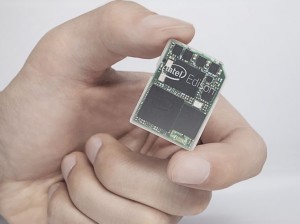 Fights among microprocessor companies happen on a platform-by-platform basis. Intel won desktop computers, ARM processors are popular in phones, AMD has a grip on the graphics market. The latest battleground is wearables, with Freescale (among others) staking a claim. But at CES, Intel made it clear that it’s coming heavy in the wearables market, and it’s going to do it with marketing as well as technology.
Fights among microprocessor companies happen on a platform-by-platform basis. Intel won desktop computers, ARM processors are popular in phones, AMD has a grip on the graphics market. The latest battleground is wearables, with Freescale (among others) staking a claim. But at CES, Intel made it clear that it’s coming heavy in the wearables market, and it’s going to do it with marketing as well as technology.
Intel CEO Brian Krzanich announced the Intel Edison reference platform — a dual-core 400MHz Quark Pentium-class processor running Linux, and a microcontroller. WiFi and Bluetooth are integrated. It’s not clear how much memory is on this thing. Developers will get their hands on it in the middle of this year.
The tech is one thing. But Intel succeeded in the mass market days of desktop computing not just with tech but with marketing smarts. (Remember “Intel Inside” and TV ads with dancing clean room workers in “bunny suits”?) On the tech marketing end, Autodesk is including Edison circuits in its 123D circuit design package. On the consumer side, Intel is putting up $1.3 million in prizes for a “Make It Wearable” campaign. Also, it’s working with the Council of Fashion Designers of America, Barneys New York, and fashion company Opening Ceremony to design a smart bracelet of some sort or another.
(Update: There’s some news in that last graf that got by me and needs to get called out specifically. Autodesk has bought circuits.io, an online hackerspace for circuit design, much like Autodesk’s excellent and popular libraries of 3D printing projects. circuits.io has been renamed 123D Circuits, and its libraries and services opened up to existing 123D customers.)
A computer that small and that powerful is going to be a big deal, if only because it will be easy to incorporate into clothing without the need to compromise fabric care (it’s easily removable) or hand (it’s so small that it can be tucked into a corner of a piece of clothing. It’s way smaller and more powerful than an Arduino or a Raspberry Pi. Stay tuned.